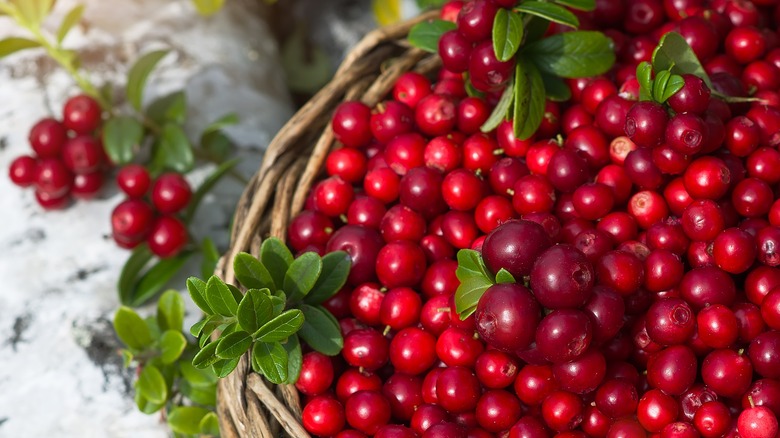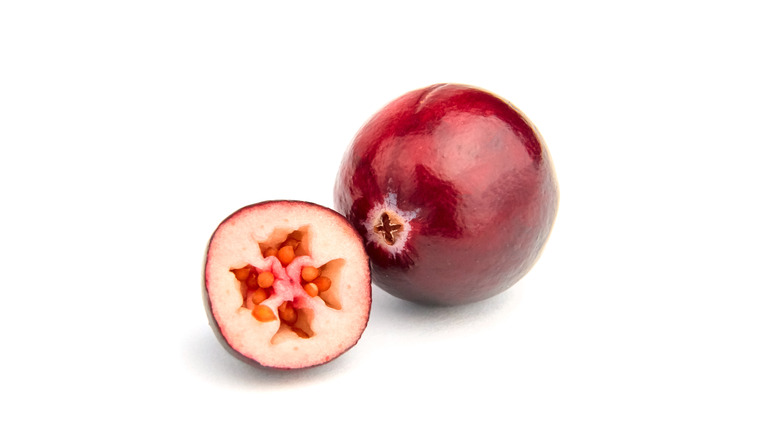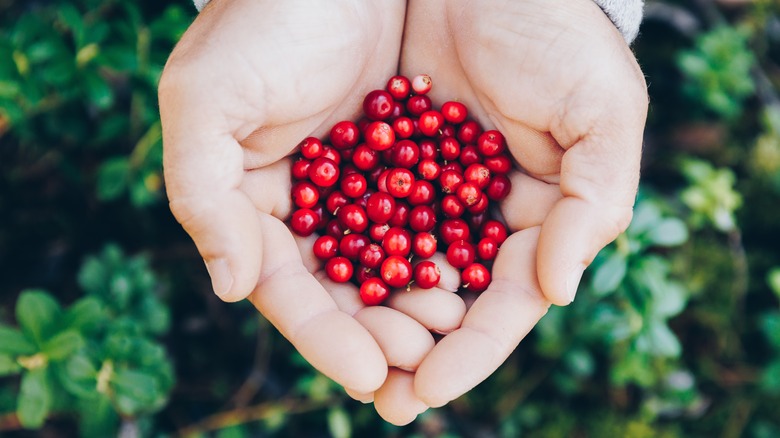Cranberries Vs. Lingonberries: What's The Difference?
There is no other fruit that evokes the image of foraging quite like the sour wild berry. Even the spare bush in a mall parking lot seems to bear tiny, hard berries, tart and unappetizing in their natural state. The closest things that we can buy at the supermarket are cranberries: Similarly red, hard, lustrous bulbs with a strong bitter flavor. Associated with winter traditions, cranberries, like prunes or chestnuts, are used like ornaments in holiday feasts, and conserved as a juice or jam for the rest of the year.
What about lingonberries, a berry that is similar in both appearance and flavor to cranberries? It's most likely that you'll be reminded of Ikea, the Swedish home decor and supply store that sells lingonberry jams and juices in their cafeteria. By default, lingonberries give the impression of being less accessible in comparison, and perhaps like an artisanal wild berry only found in Nordic winter. However, in truth, they're more widespread than we would think; so what's the real difference between lingonberries and cranberries?
Cranberries
In appearance, cranberries are shiny red berries with pockets of air in a white and yellow flesh. They taste far more sour and tart than other, sweeter berries like strawberries and blueberries. Known to be quite bitter in their raw form, cranberries are often stewed or candied with immense amounts of sugar, or dried into sweet craisins. University of Maine traces the origins of these berries back to the bogs or marshes of northeastern America, where Wampanoag People enjoyed them for more than 12,000 years. When European settlers encountered wild cranberries in America, they were reminded of other berries native to the Old World (via Cape Cod Cranberries Association). Cranberries were popularized and cultivated in Maine, where it was a vital crop to the economy of the state.
Cranberries are a great source of vitamin C, E, and K1, as well as polyphenols, which have antioxidant effects on the body, per Healthline. Like all fruits and vegetables, cranberries do diminish in vitamin content and nutritional benefits once they're processed, but certain cranberry juice brands still offer phytonutrients and tannins that help to prevent urinary tract infections and even stomach ulcers (via Healthline). In fact, PureWow notes that only 5% of cranberries are sold in their natural, raw form, while the other 95% are processed into juices, jams, or craisins. The natural bitterness of cranberries make them difficult to snack on; so if you'd like to enjoy them raw, you can use them as bright garnishes on salads or cocktails.
Lingonberries
Lingonberries belong to the same family of berries as cranberries, according to Flavorful Home. Although both lingonberries and cranberries are ruby red in color, with hard skin and delicate interiors, lingonberries have a pink or red flesh, while cranberries have white flesh (via Arctic Flavors). Interestingly enough, lingonberries were found to grow naturally in many regions across the globe, including parts of Asia, America, and, of course, northern Europe. Yet, lingonberries are harder to come by because they aren't cultivated in the States like cranberries are.
Lingonberries naturally grow in Scandinavia and other colder parts of the world, where they are picked around August and September (via Flavorful Home). Like cranberries, lingonberries are usually sold with lots of added sugar, in the form of jams or juices. However, if you were to have one of each, you'd notice that lingonberries have a hint of sweetness that cranberries lack. Furthermore, the pink and red flesh of the lingonberry is credited to its abundance of antioxidants, such as anthocyanins, per Healthline. They're also said to promote healthy gut bacteria, help modulate blood sugar levels, and improve heart health.
Can you substitute one for the other?
Yes, you can substitute cranberries for lingonberries in any recipe. After all, if you're looking for the earthy tartness of a wild berry, both berries offer the same amount of sour punch. Lingonberries and cranberries alike are most often made into sweet jams, as both have an attractive gem-colored hue and the background notes of tannins, according to NordGen.
However, Arctic Flavors points out that lingonberries are smaller than cranberries in size — so you might need more lingonberries for a garnish or to make the same amount of jam. Due to the rarity of commercially sold lingonberries in the States, you're really selling your dish with the name of the berry itself. Substitute lingonberry for cranberries, and your dish becomes more familiar and homey. Do the opposite with a cranberry-based dish, and your dish will be imbued with an air of sophistication. The touch of natural sweetness in a lingonberry also calls for less added sugar, if you're using it in the place of cranberry for any given recipe.



